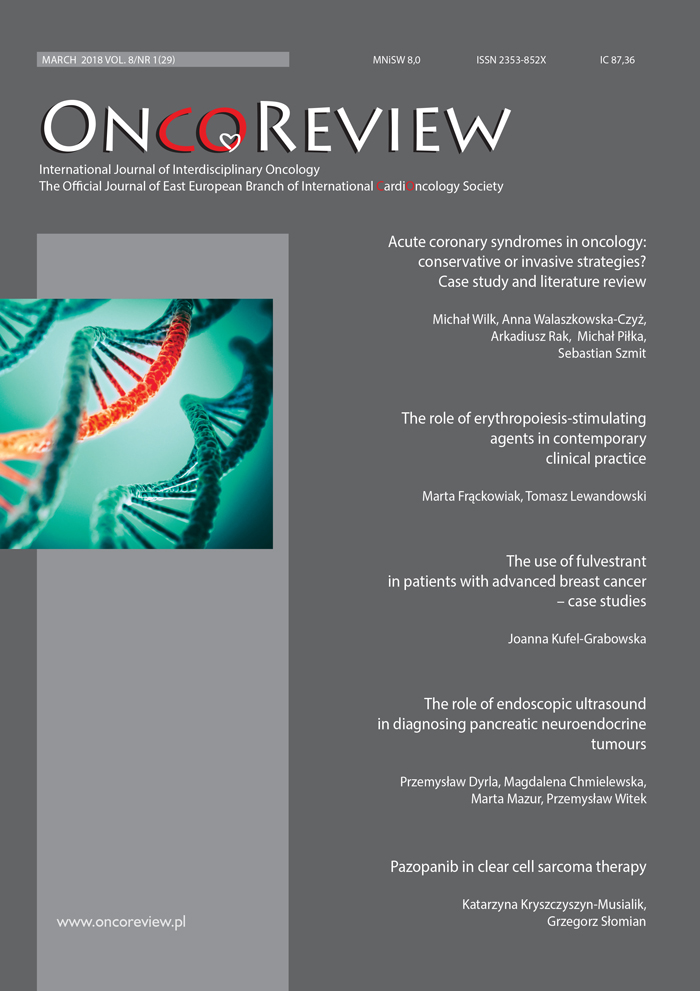Pazopanib w terapii mięsaka jasnokomórkowego – opis przypadku Case report
##plugins.themes.bootstrap3.article.main##
Abstrakt
Mięsak jasnokomórkowy jest rzadkim mięsakiem tkanek miękkich cechującym się występowaniem swoistej translokacji t(12;22)(q13;q12). Ze względu na pewne podobieństwa do czerniaka zwany jest również czerniakiem tkanek miękkich. Nowotwór ten ma charakterystyczny przebieg kliniczny. Występuje głównie u osób młodych w postaci wolno rosnącego guza, który następnie przebiega agresywnie. Przerzutuje drogą chłonną do okolicznych węzłów chłonnych, przerzuty odległe najczęściej lokalizują się w płucach. Zaawansowaną postać choroby charakteryzują bardzo agresywny przebieg i oporność na klasyczną chemioterapię.
Pobrania
##plugins.generic.paperbuzz.metrics##
##plugins.themes.bootstrap3.article.details##

Utwór dostępny jest na licencji Creative Commons Uznanie autorstwa – Użycie niekomercyjne 4.0 Międzynarodowe.
Copyright: © Medical Education sp. z o.o. This is an Open Access article distributed under the terms of the Attribution-NonCommercial 4.0 International (CC BY-NC 4.0). License (https://creativecommons.org/licenses/by-nc/4.0/), allowing third parties to copy and redistribute the material in any medium or format and to remix, transform, and build upon the material, provided the original work is properly cited and states its license.
Address reprint requests to: Medical Education, Marcin Kuźma (marcin.kuzma@mededu.pl)
Bibliografia
2. Jeziorski A. Biblioteka chirurga onkologa. Tom 3. Mięsaki tkanek miękkich. Rutkowski P. (ed). Via Medica, Gdańsk 2015: 217-221.
3. Sara AS, Evans HI, Benjamin RS. Malignant melanoma of soft parts (clear cell sarcoma): study of 30 cases. Cancer 1990; 65: 367-374.
4. Jones RL, Constantinidou A, Thway K et al. Chemotherapy in clear cell sarcoma. Med Oncol 2011; 28: 859-863.
5. Deenik W, Mooi WJ, Rutgers EJ et al. Clear cell sarcoma (malignant melanoma) of soft parts: clinicopathologic study of 30 cases. Cancer 1999; 86: 969-975.
6. Hisaoka M, Ishida T, Kuo TT et al. Clear cell sarcoma of soft tissue: a clinicopathologic, immunohistochemical and molecular analysis of 33 cases. Am J Surg Pathol 2008; 32: 452-460.
7. Kawai A, Hosono A, Nakayama R et al. Clear cell sarcoma of tendons and aponeuroses: a study of 75 patients. Cancer 2007; 109: 109-116.
8. van Akkoi AC, Verhoef C, van Geel AN et al. Sentinel node biopsy for clear cell sarcoma. Eur J Surg Oncol 2006; 32: 996-999.
9. van der Graaf WT, Blay JY, Chawla SP et al. Pazopanib for metastatic soft-tissue sarcoma (PALETTE): a randomised, double-blind, placebo-controlled phase 3 trial. Lancet 2012; 379: 1879-1886.
10. Kumar R, Knick VB, Rudolph SK et al. Pharmacokinetic-pharmacodynamic correlation from mouse to human with pazopanib, a multikinase angiogenesis inhibitor with potent antitumor and antiangiogenic activity. Mol Cancer Ther 2007; 6: 2012-2021.
11. Kuiper DR, Hoekstra HJ, Vet RP et al. The management of clear cell sarcoma. EJSO 2003; 29: 568-570.
12. Mackey SL, Hebe J, Cobb MW. Melanoma of the soft parts (clear cell sarcoma): a case report and review of the literature. J Am Acad Dermatol 1998; 38: 815-819.
13. Clark MA, Johnson MB, Thway K et al. Clear cell sarcoma (melanoma of soft parts): The Royal Marsden Hospital experience. Eur J Surg Oncol 2008; 34(7): 800-804.
14. Wagner AJ, Goldberg JM, Dubois SG et al. Tivantinib (ARQ 197), a selective inhibitor of MET, in patients with microphthalmia transcription factor-associated tumors: results of a multicenter phase 2 trial. Cancer 2012; 118: 5894-5902.
15. Liu S, Cheng H, Kwan W et al. Histone deacetylase inhibitors induce growth arrest, apoptosis and differentiation in clear cell sarcoma models. Mol Cancer Ther 2008; 7: 1751-1761.
16. Yokoyama S, Feige E, Poling LL et al. Pharmacologic suppression of MITE expression via HADAC inhibitors in the melanocyte lineage. Pigment Cell Melanoma Res 2008; 21: 457-463.
17. Outani H, Tanaka T, Wakamatsu T et al. Establishment of a novel clear cell sarcoma cell line (Hewga-CCS), and investigation of the antitumor effects of pazopanib on Hewga-CCS. BMC Cancer 2014; 14: 455.
18. Domagała-Haduch M, Jasiówka M, Nowak Ł et al. Complications of palliative antiangiogenic therapy in patients with colorectal cancer. OncoReview 2016; 6: 199-204.

